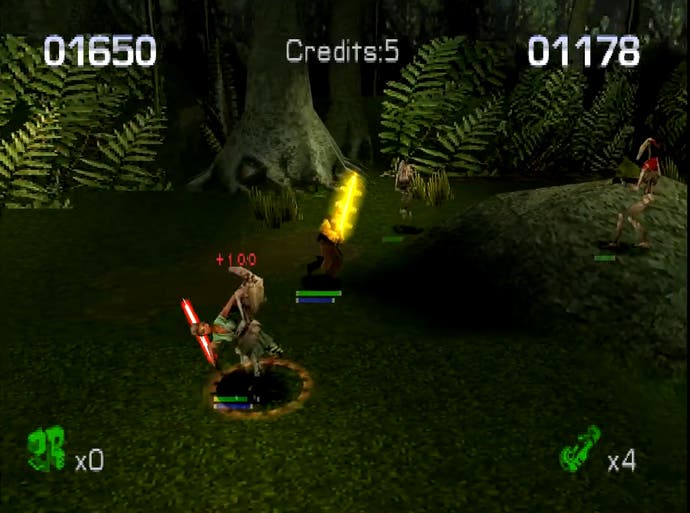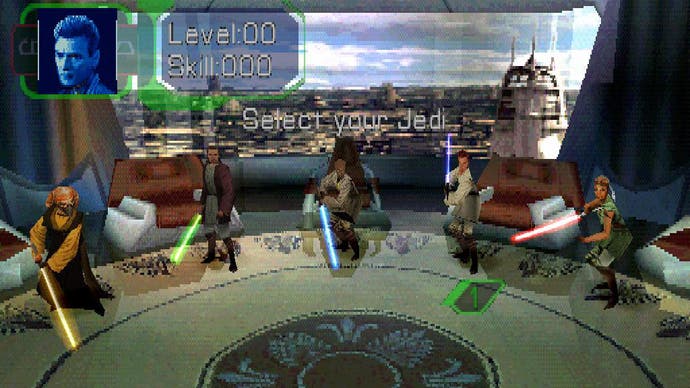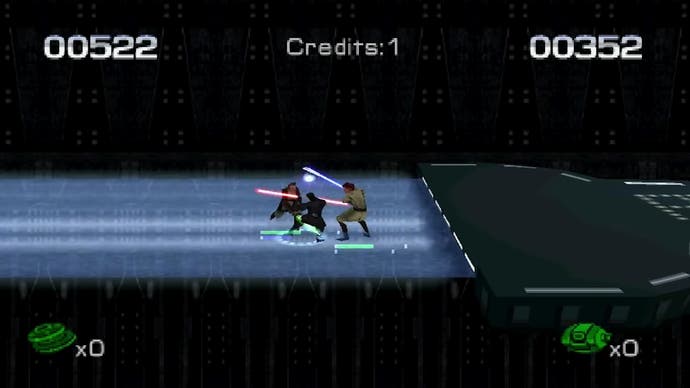Jedi Power Battles and the legacy of the Phantom Menace
Qui-Gon to the dogs.
In the first three Star Wars movies, the Jedi and Sith are dwindling embers. What was once a vast, entangled hierarchy of light and dark Force practitioners has shrunk to a handful of creaky and vindictive old men, fighting for control over a couple of angsty, unschooled kids. With 1999's prequel Star Wars I: The Phantom Menace - set in the heyday of the Galactic Republic - Lucasfilm wanted to show these crusading space mystics in their prime. The film's opening act is basically a 30-minute-long rockstar kneeslide. Obi-Wan Kenobi and Qui-Gon Jinn bust out of stage smoke and proceed to drop more bodies than you'll see fall in the entirety of the original trilogy, batting away blaster bolts without looking and throwing the Force around like confetti.
The original Star Wars trilogy's fights are closer to duels in older medieval romance flicks: you can more or less follow every blow. The Phantom Menace redefines the Jedi and Sith as crowd-pleasing stuntspeople and martial artists, their intricate choreography mixing Kendo with tennis and a few, universe-specific flourishes. Sometimes, Obi-Wan and Qui-Gon wield their sabers like feather dusters, letting the heat of the blade do the job rather than exerting their muscles. The real heroes of these encounters are their opponents, however: spindly CGI battle droids who are designed to be even more expendable than Stormtroopers. They're foes you can dismember by the hundreds without riling any age ratings boards, or risking a tabloid outcry.
The Phantom Menace is, of course, widely and correctly viewed as the worst Star Wars film ever made. It's lore rather than plot-driven, packed with racist caricatures, and bizarrely muted in its delivery, with a roster of otherwise solid actors who seem to have been pumped full of sedatives before each scene. The lightsaber fights are often called its redeeming feature. Later on, Qui-Gon and Obi-Wan have an epic three-way in the vaults of Naboo Royal Palace with Darth Maul, the soon-to-be Emperor's apprentice and wielder of a (gasp!) double-ended lightsaber. But as frenetic and impressively staged as even these fateful skirmishes are, there's something lacking here too: a sense of genuine dramatic stakes.
As the game designer and fight re-enactor Craig Page argues in a lovely craft history of Star Wars combat, Maul and the Jedi mean little to each other, and this comes across in choreography that is more about prowess than, as in Luke's clashes with Vader, a ripe old stew of fear and hatred. To the Jedi, Maul's characterisation begins and ends with Qui-Gon's remark after their first encounter on Tatooine: "It was well-trained in the Jedi arts". To the viewer, his characterisation begins and ends with that tooled-up lightsaber, which empowers him to fight the film's buddy-cop heroes simultaneously. He isn't an arch-antagonist, but merely the final boss of a production that is perhaps better understood as a vacuous, prop-heavy blueprint for generations of Star Wars videogames than a film.
The most beloved of those games are surely the later Jedi Knight sequels, Outcast and Academy, which are set long after the events of the prequel trilogy, but seize upon their more elaborate and kinetic vision of lightsaber combat. But if the Phantom Menace has a perfect videogame counterpart, I think it's Jedi Power Battles, a co-op-friendly beat 'em up starring five Jedi characters, released for PS1 in 2000. As a teenager, I was obsessed with Jedi Power Battles, partly because a close friend and I discovered it together, but also, I now realise, because it makes a virtue of the hollow spectacle of The Phantom Menace's fight scenes. Indeed, I think it's a superior realisation of certain of the film's supporting principles.

Jedi Power Battles isn't a triumph, by any stretch. It's notorious for its awful platforming sequences - the camera never quite lines up comfortably, and you're forever getting shot out of the air by Rodians lurking off-screen. It also commits the familiar Star Wars adaptation sin of having enemies who can walk off direct hits from a lightsaber: compare and contrast the 'realism' of Jedi Outcast and Academy, in which you could murder ambushing Sith by accidentally walking into them with your saber drawn. But its fixed, whole-room vantage points inevitably do a better job of recreating the bigger brawls of The Phantom Menace than the third or first-person Jedi Knight games. In particular, it means you can anticipate blaster bolts from behind and parry them back to sender - supernatural Jedi intuition redefined as a top-down view.
Placing health bars under character models also means you don't have to keep looking away from your swashbuckling Force adept while they strut their stuff (the cause of many a humiliating defeat in Jedi Academy PvP). But looking beyond these basic formal conventions, Jedi Power Battles also gets to the heart of something The Phantom Menace never quite pulled off, which is characterisation by way of duelling style.
In the absence of stirring dialogue performances, the film strains to capture each Jedi's personality through their choreography. Stunt coordinator Nick Gillard gave Obi-Wan a "businesslike style" with "flashy" touches, for example, to reflect what he's learned from the maverick Qui-Gon. Obi-Wan in turn passed this mildly hectic duelling methodology onto his own apprentice, Anakin Skywalker, who added a generous dollop of frenzy after succumbing to the Dark Side. Rewatching the Phantom Menace with that agenda in mind, I don't get much sense of this: everything feels too rehearsed, even after Maul kills Qui-Gon and thus finally grants Obi-Wan a motivation beyond "do what Master says". But it definitely comes across in Jedi Power Battles, which, of course, redoubles the emphasis on choreography as characterisation by turning combat into the primary means of progressing the plot.


The game's Obi-Wan is all staccato side-to-side swipes and double-handed overhead chops - efficient and a bit reckless, exactly as he should be. Qui-Gon is at once sturdier and more of a show-off, his combos consisting of rolling, over-the-shoulder diagonals - slower, baroque moves that are, nonetheless, better-paced to catch out droids mid-counter. Samuel Jackson's character Mace Windu cuts an even fancier figure, appropriately for a big cheese on the Jedi council. He fights one-handed, slicing horizontally and vertically with contemptuous flicks of the wrist. The other two characters are relative nobodies, but they still feel like distinct individuals. Token girl Adi Gallia does the wannabe ninja reverse-grip thing, mixing in high kicks for emphasis, while glorified pub bouncer Plo Koon wields his saber like a massive frying pan.
Outcast and Academy have far, far more technical depth than JPB, partly thanks to the industrious theory-crafters of their PvP communities, but I think they're less Star Wars stories than a hyper-specifi and gloriously ornate variation on Quake, drawing upon a separate lineage of quintessentially videogamey tactics such as cycling attack animations at range to deter or mislead, rather than being a representation of silver screen fighting or actual fencing. Even as single player experiences, they invite you to think about the Jedi you're controlling more abstractly, as bundles of moves and exploits to slot together, rather than dramatic personae expressed in the form of combos.

If I sound like I'm reaching with all this, that's entirely in keeping with how Star Wars fans have seized upon the touches of personality embedded in each movie's fight choreography, spinning them out into a full-blooded history of Jedi saber forms. According to sundry forum lore-mongers and official Expanded Universe contributors, Obi-Wan went back to basics after witnessing Qui-Gon's defeat, switching to a style called "soresu" that prioritises defence and waiting for an opening. It's fun to place these not-quite-apocryphal, not-quite-supporting narratives against the execution of fight scenes from later tentpole Star Wars shows and films. I doubt it's a direct influence, but the idea of Kenobi as a defender who drags out the match suits the recent Obi-Wan TV show, in which the title character starts out as a hermit with his back to the wall.
One thing that disappoints me about Respawn's Star Wars Jedi: Fallen Order and - from what I've glimpsed of it - the forthcoming Survivor is that they blur those characterful duelling styles into one. Cal Kestis is the Jack-of-all-Jedis required by an open world metroidvania in which you slowly acquire every tool you need to access each area and defeat every foe. He's got Darth Maul's double-ender, Kylo Ren's crossguard variant from The Force Awakens, and the option to dual-wield sabers, just for kicks. This isn't a criticism of how well the combat itself hangs together, and you can still, of course, focus on one style by prioritising specific upgrades. But making Cal an all-rounder also makes him less of a personality, and it's not like he has charisma to spare. There are very few things worth preserving from The Phantom Menace era, but I think the idea of choreography as characterisation is one of them.


